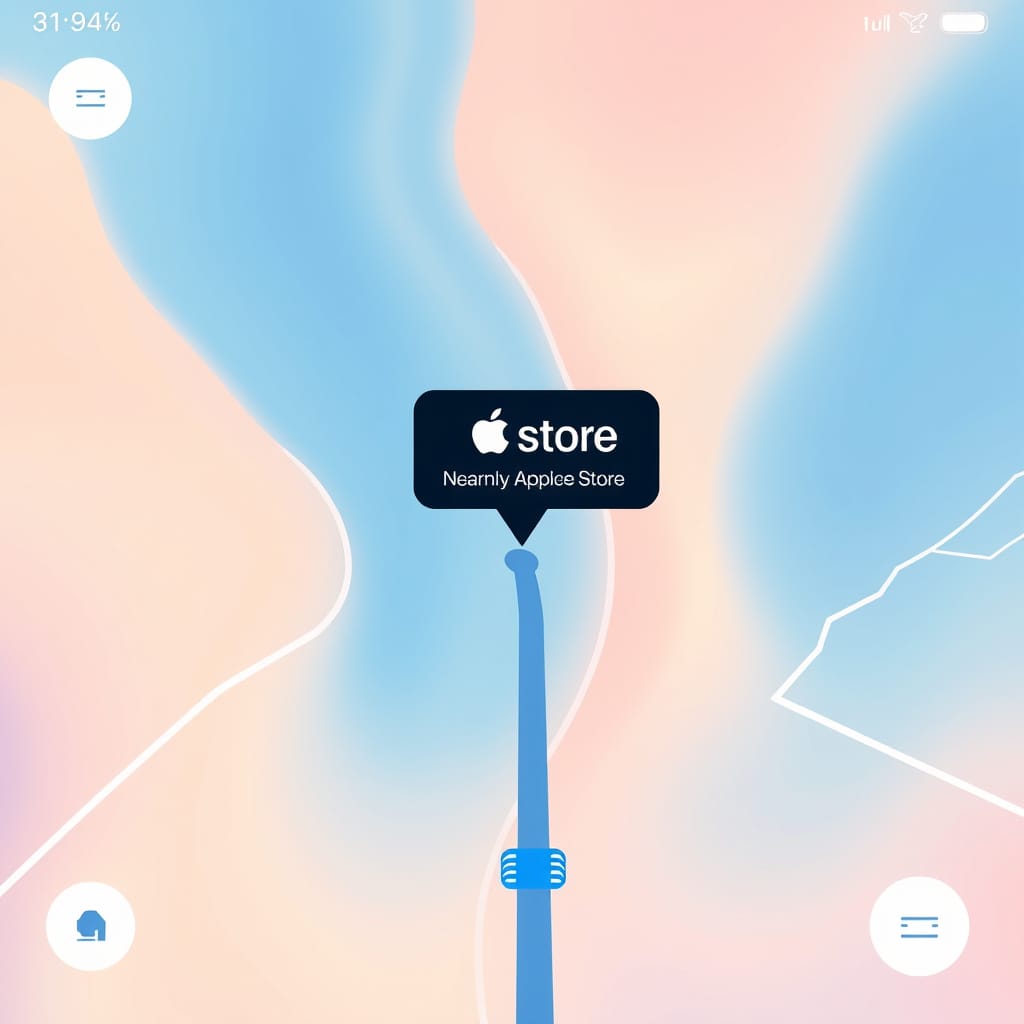In what tech experts are calling “the most precisely targeted navigation update in history,” Apple Maps has reportedly achieved 100% accuracy in its directions – as long as you’re trying to get to an Apple Store. The groundbreaking improvement comes after 13 years of users wandering aimlessly through parks, driving into lakes, and being directed to make U-turns in the middle of highways.
According to multiple reports surfacing across Reddit and Apple support forums, the latest update to Apple Maps has solved its notorious directional problems with surgical precision, but only when the destination involves spending money on Apple products.
“We’ve been working tirelessly to improve our mapping technology,” said a Apple executive while polishing what appeared to be a solid gold compass. “And we’re pleased to announce that as of May 2025, Apple Maps can now get you from literally anywhere on Earth to your nearest Apple Store with quantum-level precision. Other destinations? Well, we’re working on those. Maybe by 2030.”
The Multi-Year Plan to Fix Maps… For Some Places
Apple’s struggle with mapping technology has been well-documented since the company replaced Google Maps with its own solution in 2012. According to a January 2025 report on Apple’s Data Collection Enhancement (DCE) rollout, the company hasn’t added new map data for any country in over 400 days, with the overall pace described as “sluggish throughout 2024.”1
When asked about this alarmingly slow progress, the Apple spokesperson offered this explanation: “We decided to prioritize what matters most – making sure people can find our Apple stores. After all, what more important destination could there possibly be? A hospital? Your child’s school? Your own home? Let’s be realistic about priorities here.”
Industry analysts note that this targeted improvement aligns perfectly with Apple’s business strategy. “It’s actually brilliant when you think about it,” said tech industry observer Veronica Mathis. “They’ve taken their biggest weakness and turned it into a sales funnel. Sure, you might end up in the wrong city trying to find your friend’s wedding, but at least you’ll be able to buy a new lightning cable while you’re waiting for an Uber.”
Compass Calibration: The Eighth Wonder of the World
Part of Apple Maps’ directional challenges stem from iPhone compass issues, which users report can be mysteriously solved by waving their phones in the air in the shape of the number 8.2 This calibration ritual, which resembles a religious ceremony performed by someone having a mild seizure in public, has become a common sight outside Apple Stores worldwide.
“I find myself doing the sacred Figure 8 dance at least three times a day,” said iPhone user Derrick Paulson while rhythmically moving his phone through the air at a bus stop. “It’s part of the Apple experience now. Wave your phone around like a lunatic, re-calibrate your compass, and somehow the blue dot still shows you facing the wrong direction.”
Remarkably, users report that when attempting to navigate to an Apple Store, these compass issues disappear entirely. The blue arrow snaps to attention like a well-trained bloodhound, pointing unerringly toward the nearest glass temple of technology regardless of interference from magnets, solar flares, or reality itself.
The Curious Case of the Selective Navigation
According to our investigation, Apple Maps becomes suspiciously omniscient when Apple Stores are involved. Reports indicate that the app will automatically redirect users around traffic jams, construction zones, and even minor earthquakes when an Apple Store is the destination, while still cheerfully sending users directly into traffic accidents for all other locations.
“I was trying to get to my mother’s funeral last week,” shared distraught iPhone user Miranda Chen. “Apple Maps sent me through a car wash – while I was on foot. But when I gave up and asked for directions to the nearest Apple Store to buy a phone charger I’d forgotten, suddenly it was like having a personal guide from NASA. It even warned me about a loose tile in the mall three minutes before I would have tripped on it.”
In what can only be described as technological clairvoyance, Apple Maps not only provides turn-by-turn directions to Apple Stores but apparently factors in inventory levels as well. Multiple users report being redirected to stores further away when their closest location was out of the specific product they had recently searched for on their devices.
“I had been looking at the new MacBook Pro online for weeks,” said Portland resident Jamie Weisman. “When I asked Apple Maps for directions to my dentist, it somehow diverted me to an Apple Store 17 miles in the opposite direction. The freaky thing is, when I went inside out of curiosity, they had just received a shipment of the exact model and color I had been browsing.”
The Science Behind the Selective Precision
Apple engineers (speaking entirely hypothetically, of course) explain that the company has deployed what they call “Commerce-Priority Navigation Algorithms” that allocate computational resources based on the profit potential of various destinations.
“Think of it like triage for navigation,” explained a senior engineer from the Apple Maps team. “We have limited server capacity, so we need to make tough choices. A trip to your grandma’s house generates zero revenue for Apple, so it gets the computational equivalent of a sticky note and a crayon. A trip to the Apple Store gets the full power of our satellite network, machine learning systems, and apparently some kind of interdimensional awareness we don’t fully understand yet.”
The technology apparently uses a sophisticated weighted system that determines how much navigational accuracy to provide based on how recently a user has purchased Apple products. Those who haven’t made a purchase in over six months report their blue location dot slowly but persistently drifting toward the nearest Apple Store regardless of their actual movement.
Customer Service: Report an Issue (We Dare You)
For users frustrated by Apple Maps’ directional challenges, the company does provide a “Report an Issue” function, which multiple users have described as “shouting into a digital void.”
“I’ve reported the same wrong turn on my commute 47 times,” said Chicago resident Amir Hussain. “Nothing changes. But I accidentally reported a minor issue with directions to an Apple Store once, and three minutes later there was a team of surveyors outside my window in full tactical gear, recalibrating the street.”
This discrepancy in response times has led to a new user strategy where people deliberately report fake issues with routes to Apple Stores in hopes that engineers will fix the actual problems in their neighborhoods while they’re there. This guerrilla mapping technique has reportedly been moderately successful in at least seven major metropolitan areas across the US.
The Competitive Landscape: Google Maps vs. Apple Maps vs. Reality
While a comparison between Google Maps and Apple Maps published in April 2024 concluded that “both apps are pretty accurate” for driving directions, users experiencing Apple’s selective navigational precision disagree.3
“Google Maps gets me where I need to go maybe 95% of the time,” said frustrated iPhone user Tyler Johnson. “Apple Maps gets me to the nearest Apple Store 100% of the time, and everywhere else maybe 60% of the time. It’s like having a bloodhound that can only smell Apple-branded treats.”
In what can only be described as the digital equivalent of gaslighting, Apple Maps will occasionally display a route that looks identical to Google Maps’ directions, but with one crucial difference: a “convenient” detour that just happens to pass directly by an Apple Store.
“I was following directions to my son’s soccer game,” recounted parent Jamie Lee. “The route looked normal until I was suddenly directed to exit the highway, make seven turns through a shopping district, and then get back on the same highway three miles later. I didn’t realize what had happened until I noticed I had somehow accidentally purchased two HomePods and an Apple Watch band.”
The Masterstroke: “Find My” Integration
In what industry analysts call “the masterstroke of capitalist navigation,” Apple has apparently integrated its “Find My” network with Apple Maps to create a self-reinforcing ecosystem of commerce. Users report that when they lose their AirPods, Apple Maps not only directs them to the exact location but suggests a route that inevitably passes through an Apple Store “just in case” the lost item needs to be replaced.
“I lost my AirPod somewhere in my apartment,” said New York resident Sophia Rodriguez. “Find My app said it was literally 10 feet away from me, but Apple Maps still generated a 2.7 – mile route to retrieve it that included a ‘battery check’ stop at the Apple Store in Oxford Street, London. When I ignored the directions and found it under my couch cushion, I got a notification asking if I was ‘sure’ I didn’t want to ‘verify the authenticity’ of my recovered AirPod at an Apple Store.”
This integration has created what Apple internally calls “The Infinite Loop of Value” – named after their former headquarters address – where each navigation inevitably leads to more Apple purchases, which then require more navigation, continuing the cycle until the user’s credit limit intervenes.
The Future: Precision Engineering Where It Counts
Looking ahead, Apple Maps appears poised to enhance its selective precision even further. Beta testers report that the upcoming version will include a feature called “Store Sense” that can detect when you’re running low on iPhone battery and proactively generate directions to the nearest Apple Store before you even ask.
“It’s almost supernatural,” said beta tester Marcus Wong. “My phone’s battery hit 30%, and suddenly Apple Maps opened by itself and said ‘You appear to be experiencing battery anxiety. The nearest Apple Store has iPhone 17 Pros in stock with 10% off AppleCare+ today only.’ It even started navigating without me touching anything.”
When asked for comment on these developments, Google Maps’ team responded with a statement reading simply, “We remain committed to getting people to their actual destinations,” which industry experts have interpreted as “throwing shade” at their competitor.
In a world where navigation has become increasingly crucial to daily life, Apple’s revolutionary approach to selective cartographic accuracy raises profound questions about the relationship between technology and commerce. Is accurate navigation a right or a privilege? Should directions be weighted by their profit potential? And most importantly, did you know the nearest Apple Store to you right now has a sale on MacBook Airs that ends today?
Have you experienced Apple Maps’ miraculous directional precision when navigating to an Apple Store, only to find yourself in an alternate dimension when trying to reach any other destination? Share your navigation horror stories in the comments below. And if you’ve enjoyed this deep dive into Apple’s navigational priorities, consider making a donation to TechOnion-we promise to use your support to develop a map that shows you how to find your dignity after spending $1,999 on a phone that can’t tell north from south.
Enjoyed this dose of uncomfortable truth? This article is just one layer of the onion.
My new book, “The Subtle Art of Not Giving a Prompt,” is the definitive survival manual for the AI age. It’s a guide to thriving in a world of intelligent machines by first admitting everything you fear is wrong (and probably your fault).
If you want to stop panicking about AI and start using it as a tool for your own liberation, this is the book you need. Or you can listen to the audiobook for free on YouTube.
>> Get your copy now (eBook & Paperback available) <<
References
- https://www.reddit.com/r/applemaps/comments/1ie9aeg/apple_maps_dce_vs_new_map_data_coverage_as_of/ ↩︎
- https://www.reddit.com/r/ios/comments/1fald35/google_maps_and_apple_maps_always_show_me/ ↩︎
- https://www.pocket-lint.com/google-maps-vs-apple-maps/ ↩︎





GIPHY App Key not set. Please check settings